Page 11 of 400
9
.Visual search
308_EN_CHAP00B_ AIDE VISUELLE_ED02-2013
Maintenance - Technical data
Dimensions 286 Identification markings 287
Running out of fuel, Diesel 270
Checking levels 280 -282 - oil - brake fluid - coolant - screenwash, headlamp wash fluid - additive (Diesel with particle emissions filter) Checking components 283 -284 - battery - air / passenger compartment filter - oil filter - particle emissions filter (Diesel) - brake pads / discs
Changing bulbs 235-244 - front - rear
12V battery 251-254 Load reduction, economy mode 255 Engine compartment fuses 245, 249 -250
Opening the bonnet 267 Under the bonnet, petrol 268 Under the bonnet, Diesel 269 Petrol engines 285 AdBlue 271-279
Weights 285
Page 13 of 400
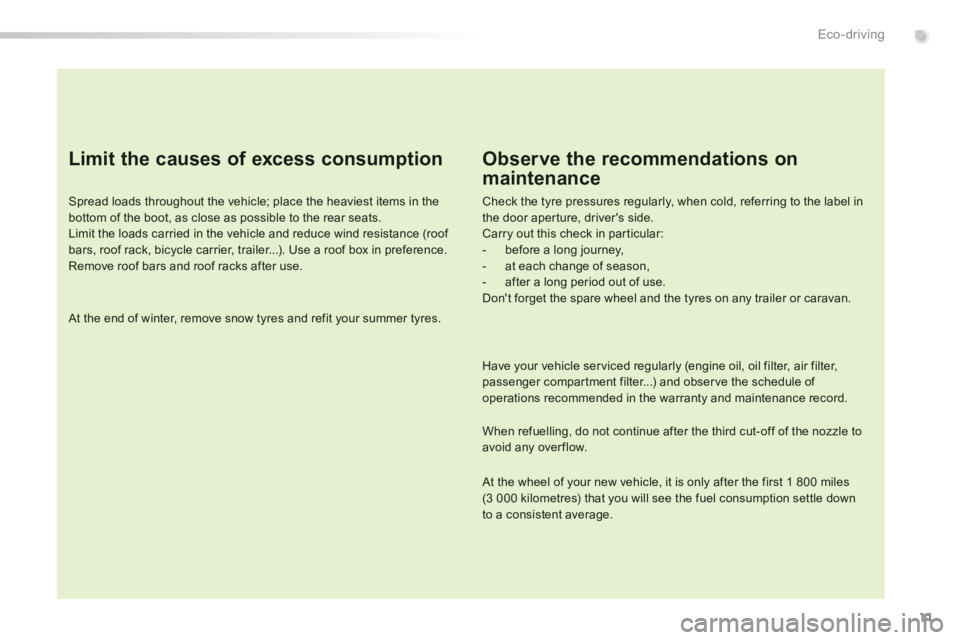
11
.Eco-driving
308_EN_CHAP00C_ECO CONDUITE_ED02-2013
Limit the causes of excess consumption
Spread loads throughout the vehicle; place the heaviest items in the bottom of the boot, as close as possible to the rear seats. Limit the loads carried in the vehicle and reduce wind resistance (roof bars, roof rack, bicycle carrier, trailer...). Use a roof box in preference. Remove roof bars and roof racks after use.
At the end of winter, remove snow tyres and refit your summer tyres.
Observe the recommendations on
maintenance
Check the tyre pressures regularly, when cold, referring to the label in the door aperture, driver's side. Carry out this check in particular: - before a long journey, - at each change of season, - after a long period out of use. Don't forget the spare wheel and the tyres on any trailer or caravan.
Have your vehicle serviced regularly (engine oil, oil filter, air filter, passenger compartment filter...) and observe the schedule of operations recommended in the warranty and maintenance record.
When refuelling, do not continue after the third cut-off of the nozzle to avoid any over flow.
At the wheel of your new vehicle, it is only after the first 1 800 miles (3 000 kilometres) that you will see the fuel consumption settle down to a consistent average.
Page 21 of 400
19
1
Monitoring
308_EN_CHAP01_CONTROLE DE MARCHE_ED02-2013
Warning / indicator lampStateCauseAction / Observations
Service on temporarily. A minor fault has occurred for which there is no specific warning lamp. Identify the fault by means of the associated message, such as: - low engine oil level, - low screenwash/headlamp wash fluid level, - discharged remote control battery, - low tyre pressures, - saturation of the particle emission filter (PEF) on Diesel vehicles. For more information on the PEF, refer to the "Checks - particle emissions filter" section. For any other faults, contact a PEUGEOT dealer or a qualified workshop.
fixed. A major fault has occurred for which there is no specific warning lamp. Identify the fault by reading the message and contact a PEUGEOT dealer or a qualified workshop.
Page 26 of 400
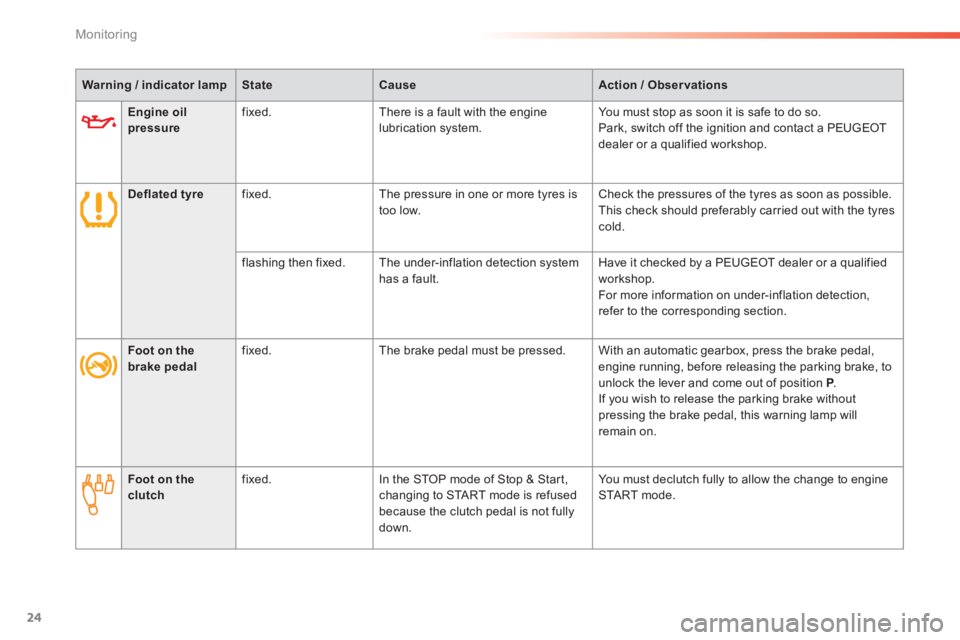
24
Monitoring
308_EN_CHAP01_CONTROLE DE MARCHE_ED02-2013
Engine oil pressure fixed. There is a fault with the engine lubrication system. You must stop as soon it is safe to do so. Park, switch off the ignition and contact a PEUGEOT dealer or a qualified workshop.
Deflated tyre fixed. The pressure in one or more tyres is too low. Check the pressures of the tyres as soon as possible. This check should preferably carried out with the tyres cold.
flashing then fixed. The under-inflation detection system has a fault. Have it checked by a PEUGEOT dealer or a qualified workshop. For more information on under-inflation detection, refer to the corresponding section.
Warning / indicator lampStateCauseAction / Observations
Foot on the brake pedal fixed. The brake pedal must be pressed. With an automatic gearbox, press the brake pedal, engine running, before releasing the parking brake, to unlock the lever and come out of position P . P . P If you wish to release the parking brake without pressing the brake pedal, this warning lamp will remain on.
Foot on the clutch fixed. In the STOP mode of Stop & Start, changing to START mode is refused because the clutch pedal is not fully down.
You must declutch fully to allow the change to engine START mode.
Page 29 of 400
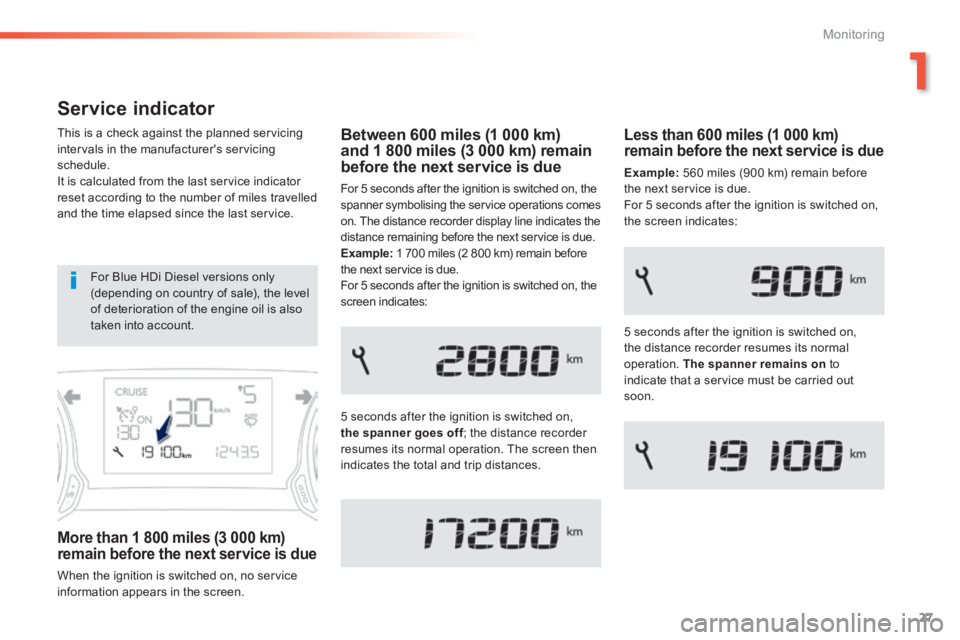
27
1
Monitoring
308_EN_CHAP01_CONTROLE DE MARCHE_ED02-2013
Service indicator
This is a check against the planned servicing intervals in the manufacturer's servicing schedule. It is calculated from the last service indicator reset according to the number of miles travelled and the time elapsed since the last service.
More than 1 800 miles (3 000 km) remain before the next service is due
When the ignition is switched on, no service information appears in the screen.
Less than 600 miles (1 000 km) remain before the next service is due
Example: 560 miles (900 km) remain before the next service is due. For 5 seconds after the ignition is switched on, the screen indicates:
Between 600 miles (1 000 km) and 1 800 miles (3 000 km) remain before the next service is due
For 5 seconds after the ignition is switched on, the spanner symbolising the service operations comes on. The distance recorder display line indicates the
distance remaining before the next service is due. Example: 1 700 miles (2 800 km) remain before the next service is due. For 5 seconds after the ignition is switched on, the screen indicates:
5 seconds after the ignition is switched on, the spanner goes off ; the distance recorder the spanner goes off ; the distance recorder the spanner goes offresumes its normal operation. The screen then indicates the total and trip distances.
5 seconds after the ignition is switched on, the distance recorder resumes its normal operation. The spanner remains on to indicate that a service must be carried out soon.
For Blue HDi Diesel versions only (depending on country of sale), the level of deterioration of the engine oil is also taken into account.
Page 31 of 400
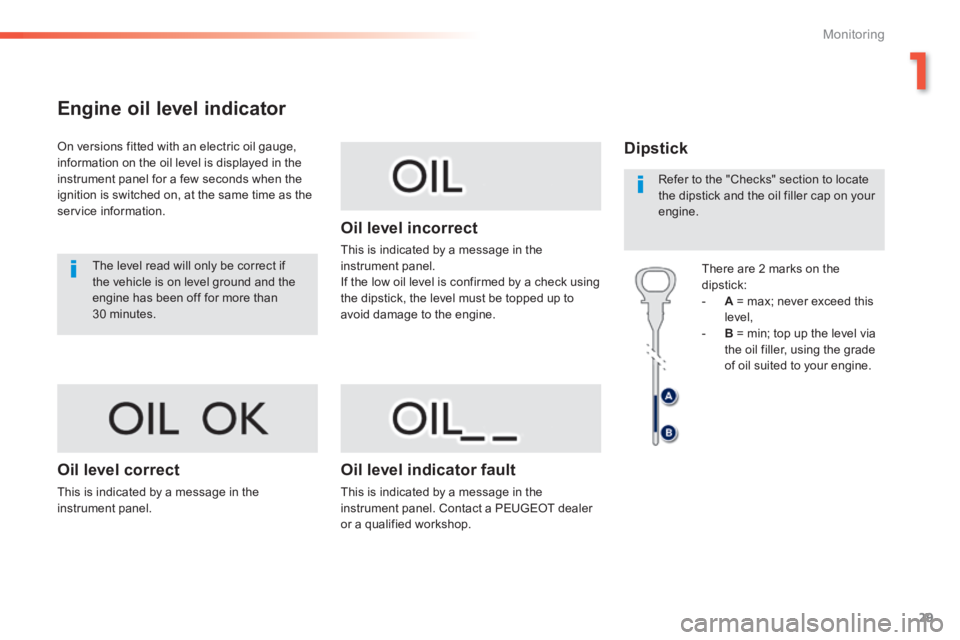
29
1
Monitoring
308_EN_CHAP01_CONTROLE DE MARCHE_ED02-2013
Engine oil level indicator
On versions fitted with an electric oil gauge, information on the oil level is displayed in the instrument panel for a few seconds when the ignition is switched on, at the same time as the service information.
The level read will only be correct if the vehicle is on level ground and the engine has been off for more than 30 minutes.
Oil level correct
This is indicated by a message in the instrument panel.
Oil level incorrect
This is indicated by a message in the instrument panel. If the low oil level is confirmed by a check using the dipstick, the level must be topped up to avoid damage to the engine.
Oil level indicator fault
This is indicated by a message in the instrument panel. Contact a PEUGEOT dealer or a qualified workshop.
Dipstick
There are 2 marks on the dipstick: - A = max; never exceed this level, - B = min; top up the level via the oil filler, using the grade of oil suited to your engine.
Refer to the "Checks" section to locate the dipstick and the oil filler cap on your engine.
Page 225 of 400
223
7
Practical information
308_EN_CHAP07_INFO PR ATIQUES_ED02-2013
Repair procedure
1. Sealing
Uncoil the white pipe G fully. Unscrew the cap from the white pipe. Connect the white pipe to the valve of the tyre to be repaired.
Connect the compressor's electric plug to the vehicle's 12 V socket. Start the vehicle and leave the engine running.
Take care, this product is harmful (e.g. ethylene-glycol, colophony...) if swallowed and causes irritation to the eyes. Keep this product out of the reach of children.
Avoid removing any foreign bodies which have penetrated into the tyre.
Do not start the compressor before connecting the white pipe to the tyre valve: the sealant product would be expelled through the pipe.
Switch off the ignition.
Turn the selector A to the "sealant" position. Check that the switch B is in position "O" .
Page 228 of 400
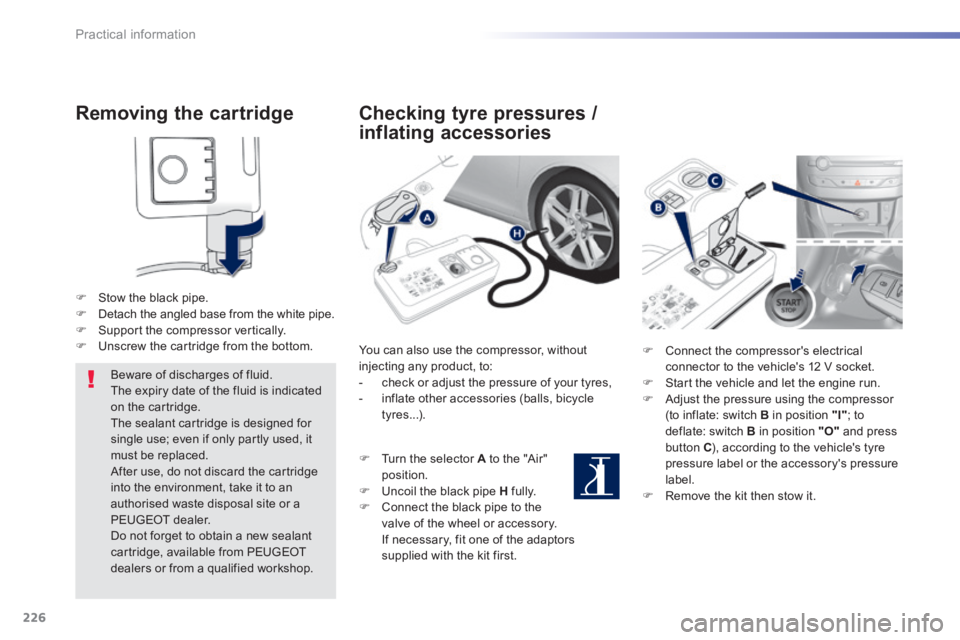
226
Practical information
308_EN_CHAP07_INFO PR ATIQUES_ED02-2013
Removing the cartridge
Stow the black pipe. Detach the angled base from the white pipe. Support the compressor vertically. Unscrew the cartridge from the bottom.
Beware of discharges of fluid. The expiry date of the fluid is indicated on the cartridge. The sealant cartridge is designed for single use; even if only partly used, it must be replaced. After use, do not discard the cartridge into the environment, take it to an authorised waste disposal site or a PEUGEOT dealer.
Do not forget to obtain a new sealant cartridge, available from PEUGEOT dealers or from a qualified workshop.
Checking tyre pressures /
inflating accessories
You can also use the compressor, without injecting any product, to: - check or adjust the pressure of your tyres, - inflate other accessories (balls, bicycle tyres...).
Turn the selector A to the "Air" position. Uncoil the black pipe H fully. Connect the black pipe to the valve of the wheel or accessory. If necessary, fit one of the adaptors supplied with the kit first.
Connect the compressor's electrical connector to the vehicle's 12 V socket. Start the vehicle and let the engine run. Adjust the pressure using the compressor (to inflate: switch B in position "I" ; to deflate: switch B in position "O" and press button C ), according to the vehicle's tyre pressure label or the accessory's pressure label. Remove the kit then stow it.